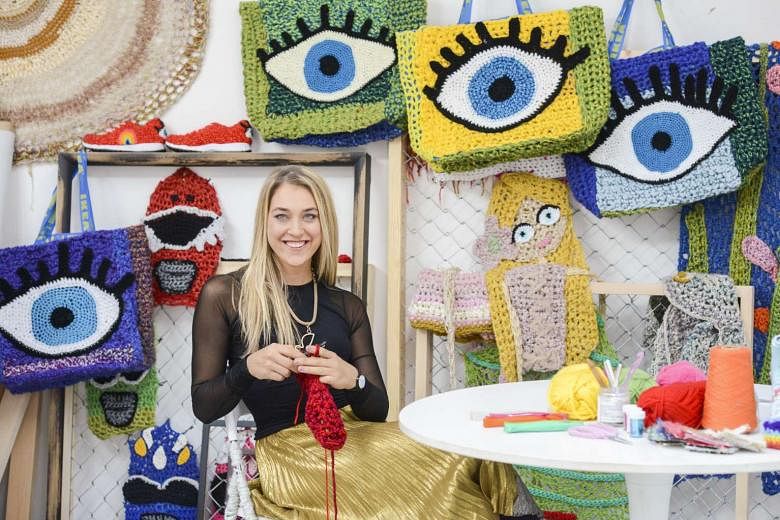NEW YORK • Not long ago, a street artist named London Kaye became embroiled in an unexpected controversy.
A flea market in Brooklyn partnered her to create a large-scale installation. So she crocheted a portrait, measuring 4.5m by 3m, of Sam Shakusky from Wes Anderson's Moonrise Kingdom (2012) holding hands with the creepy twins from The Shining (1980).
"It was about young love," she said.
Not everyone was charmed. Although Kaye, 28, did not know, the flea market had not secured permission to hang her work on an adjacent building. Anti-gentrification activists took their frustrations against her to social media. Weblog Gothamist reported that one aggrieved person equated Kaye and her work to "colonisers who claim indigenous lands for themselves".
"I was the perfect scapegoat," she said. She took the installation down.
Her genre of street art, known as "yarn bombing", has been widely derided as a hipster fad or dismissed as cutesy, mere "women's work". But in Kaye's hands, crochet is both an outlet of creative feminist expression and a lucrative career. Her work is appearing throughout the culture, from high fashion to the heart of the mass market.
There is no question that the needle arts are having a moment.
"It used to be that a lot of people didn't like crochet or relegated it to your mother's afghan, but there's been a big renaissance," said Trisha Malcolm, editor-in-chief of Vogue Knitting.
She pointed to designers such as ICB, Ryan Roche, Rosetta Getty and Tommy Hilfiger, who are "updating traditional techniques", moving around sweater cables, creating big holes and crocheting bikinis.
This year also saw the release of the critically acclaimed documentary Yarn, about international yarn bombers, and the Museum of Arts and Design in New York is exhibiting an elaborate crochet coral reef.
Vogue Knitting has just begun a redesign and expects to turn out 8,000 people at its Vogue Knitting Live symposium in Times Square next month. Kaye is crocheting 10 historic Vogue covers for the event.
"You've still got the core crocheter who buys acrylics in Wal-Mart," Malcolm said. "But it's a big trend in the younger kids. London is almost like a spokesperson for that group. She's the super-creative crocheter who will cover anything."
Among Kaye's projects this year were the facade of a school bus for a Gap commercial and an installation of television host Conan O'Brien. She also designed 18 window displays for Valentino and a five-piece capsule collection for the brand, featuring a crochet applique of herself. "I love dressing my crochet girl up, making her fun and fabulous and putting her in weird situations," she said.
She quit her day job, at an Apple Genius Bar in Manhattan, a year ago, but still seems awed by the demand for her work. She learnt about yarn bombing four years ago, when she happened to sell a computer to Agata Oleksiak, one of the world's most pre-eminent yarn artists. "She had a crazy crochet bag," Kaye said. "I started Googling her."
After reading about Oleksiak, she wrapped a scarf she had made around a tree outside her apartment. She assumed someone would rip it down, but nobody did. Kaye then gave herself a challenge: Yarn bomb something new for 30 consecutive days. She made it to 50.
Although she said she has been stopped by the police four times, her work attracted positive attention. In 2014, a Starbucks store designer spotted 10 Nutcracker dancers she had hung on a fence. Soon, it hired her to yarn bomb around a new Brooklyn store location. Valentino contacted her after seeing a video of subway poles she had adorned.
In the past three years, Kaye has created a textile collection for ABC Carpet & Home and worked on social media and commercials for Isaac Mizrahi Craft and Delivery.com.
Of course, not everyone applauds the appropriation of a once-subversive practice by corporate marketing departments. "Some street artists think working with brands is selling out," she said. "But I don't think 'starving artist' should be a thing."
Indeed, making money from her work arguably augments its feminist impact. "In a male-dominated art form," she said, referring to street art, "I like being able to have my two cents. I hope I can inspire people to do something daring. Ladies, get out there."
NYTIMES

